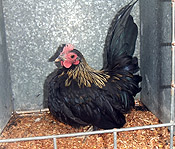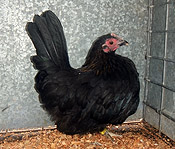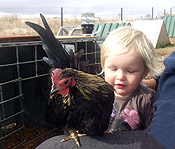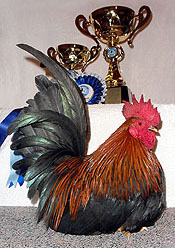

Show preparation
 I single out likely show birds at a very young age. The best ones seem to stand out right from a few weeks of age. I find the chicks that grow fast and are the most boisterous, seldom turn out as good show birds. Rather, it is the smaller; less vigorous-looking chick that oftens end up the best. Perhaps that is just my line, who knows? Providing these chicks are raised carefully and protected from bullying, they always grow out strong and active.
I single out likely show birds at a very young age. The best ones seem to stand out right from a few weeks of age. I find the chicks that grow fast and are the most boisterous, seldom turn out as good show birds. Rather, it is the smaller; less vigorous-looking chick that oftens end up the best. Perhaps that is just my line, who knows? Providing these chicks are raised carefully and protected from bullying, they always grow out strong and active.

I allow the pullets to run out in small groups and I handle them just a little to get them quiet. I find they feather out better this way.
The cockerels are penned into individual cages about 3 feet square and handled daily. In this way they train more easily in the smaller show pens. They are allowed to run out once or twice a week for exercise.

To gain the edge to win in good competition, pen training is extremely important.
Once the birds are in full training, they are tempted with tiny bits of bread to come to the front of the cage. It doesn't take long before they are bold enough to take it right out of the fingers and once they get to this stage, they are far less worried about being handled.
My thoughts on the judging of Japanese bantams
It is quite rare for a Japanese bantam to win a major award in open competition and this is not always because they are of lesser quality than birds of other breeds in the show.

Many judges simply do not understand the breed and will card birds that don't conform to the breed standard. I once heard a judge laugh when he reached the Japanese bantam classes and hardly bothered to look at them at all. When queried about his attitude, his reply was: "they're only Japs, after all". Judges like that should not put themselves forward to judge breeds they obviously know and care so little about.

Another problem is that many judges don't know how to get the best out of Japanese bantams and don't handle them properly. A lot of judges use a judging stick on them which is undesirable as it makes the birds want to stand up instead of sitting low as the standard demands. Like Pekin bantams, Japanese bantams should be set down quietly and low to the ground, not stirred up and nervous.
Watching these judges is frustrating as birds that have been prepared and trained to perfection are denied any chance at winning top awards because of ignorance and stupidity.
I usually train my birds to accept the stick so that should the judge use one, the birds will not be unduly bothered by it and will stay relaxed and settled, although it is something that, in a perfect world, shouldn't need doing.

